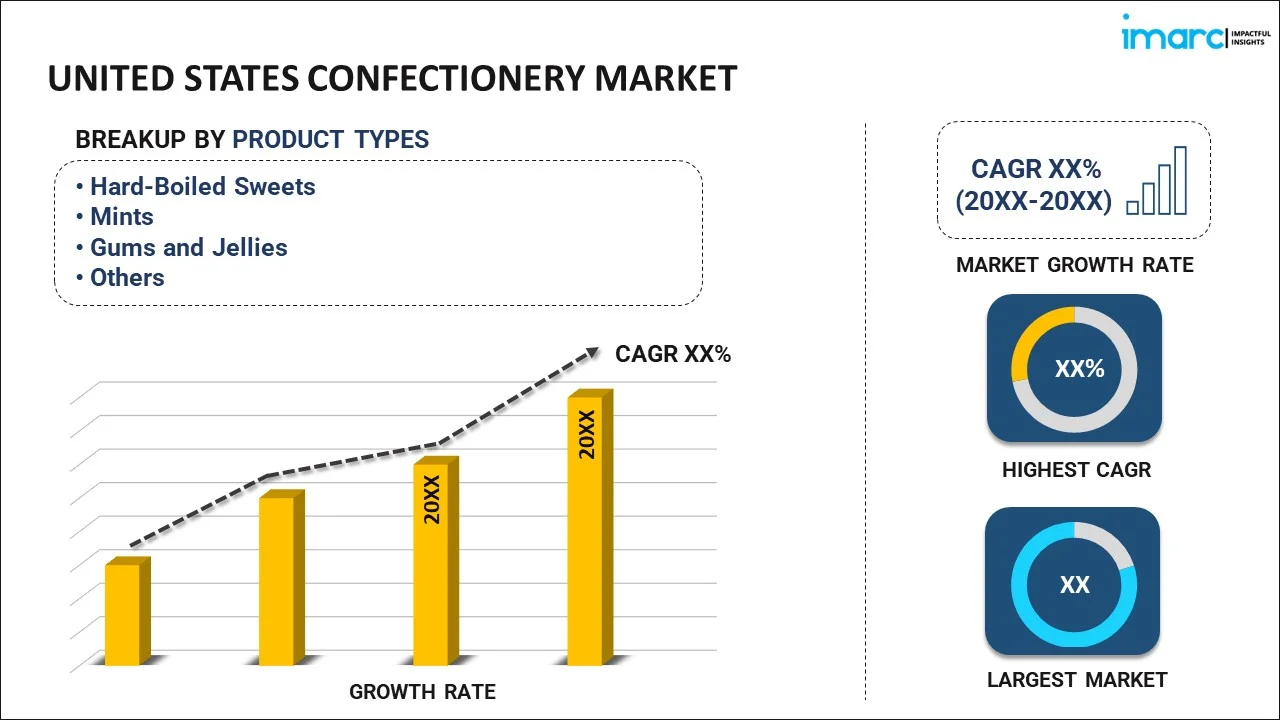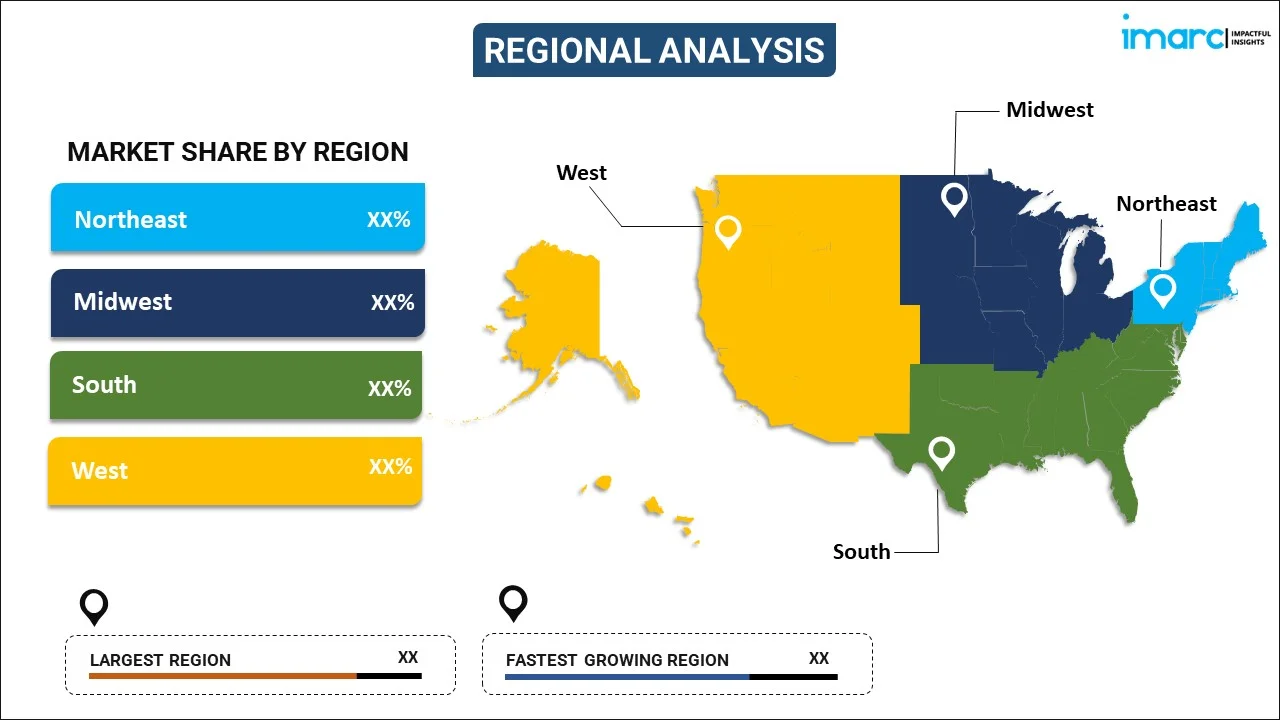
United States Confectionery Market Report by Product Type (Hard-Boiled Sweets, Mints, Gums and Jellies, Chocolate, Caramels and Toffees, Medicated Confectionery, Fine Bakery Wares, and Others), Age Group (Children, Adult, Geriatric), Price Point (Economy, Mid-Range, Luxury), Distribution Channel (Supermarkets and Hypermarkets, Convenience Stores, Pharmaceutical and Drug Stores, Online Stores, and Others), and Region 2025-2033
United States Confectionery Market Size, Share & Analysis:
United States confectionery market size reached USD 39.9 Billion in 2024. Looking forward, IMARC Group expects the market to reach USD 54.1 Billion by 2033, exhibiting a growth rate (CAGR) of 3.46% during 2025-2033. The introduction of numerous flavors, textures, and portion sizes by key players to cater to diverse palates and the inflating popularity of premium packaging are primarily driving the market growth.
United States Confectionery Market Insights:
- Major Market Drivers: The United States confectionery market is fueled by increasing disposable incomes, indulgent snacking needs, and seasonal gifting practices. Growth is also underpinned by product innovation in flavor, format, and healthier options geared towards changing consumer needs.
- Key Market Trends: The market is observing rising demand for premium, clean-label, and functional confections. Some of the trends observed are artisanal chocolate, low-sugar candies, and e-commerce-enabled sales, indicating shifting lifestyles and dietary consciousness in the United States confectionery market.
- Competitive Landscape: The competitive environment is characterized by innovation, brand loyalty, and aggressive marketing through digital and retail channels. Both established brands and specialized players commit investments in product development and packaging to remain relevant and gain market share.
- Challenges and Opportunities: Challenges are regulatory intensity on sugar levels and changing health priorities. Opportunities emerge through functional ingredients, sustainably packaged products, and direct-to-consumer models that have the ability to redefine United States confectionery market growth over the next few years.
|
Report Attribute
|
Key Statistics
|
|---|---|
|
Base Year
|
2024
|
|
Forecast Years
|
2025-2033
|
|
Historical Years
|
2019-2024
|
|
Market Size in 2024
|
USD 39.9 Billion |
|
Market Forecast in 2033
|
USD 54.1 Billion |
| Market Growth Rate 2025-2033 | 3.46% |
Confectionery encompasses a broad range of sweet food items skillfully crafted with artistic expertise. This category includes a variety of sugary delights, such as candies, chocolates, pastries, and other sweet treats. Typically enjoyed as desserts, snacks, or special gifts, confectionery products are the result of a combination of culinary skill and creative expression. From elaborately designed cakes to straightforward yet delightful candies, these sweet creations cater to diverse preferences. Confectionery has a universal appeal, adding joy and sweetness to various occasions and celebrations. It serves as a testament to the seamless blend of culinary mastery and imaginative craftsmanship, making it a delightful and appreciated aspect of the culinary world.
United States Confectionery Market Trends:
Premium and Artisanal Confectionery
The movement towards advanced taste preferences is fueling high consumer demand for premium and artisan confectionery. Consumers increasingly desire better ingredients, unique flavor profiles, and higher aesthetics in products. Innovations with single-origin cocoa, floral infusions, and exotic fruits are going mainstream as palates evolve. Packaging also comes into play, with heightened focus on refined, eco-friendly designs that echo product sophistication. Artisanal-style confections are seen not only as decadent snacks but also as luxury gift items. This trend intersects with overall lifestyle desires focused on conscious indulgence and refined experiences. At the same time, health-oriented consumers are willing to pay a premium for clean-label and ethically sourced confections, focusing on fewer artificial ingredients and traceable origins. With the convergence of taste and ethics, the category is changing very quickly. This change is a key driver behind the growing United States confectionery market share, placing it on solid ground for sustained growth across both mass and niche channels.
Functional and Better-for-You Innovations
Health-conscious consumers are redefining indulgence by turning towards confectionery that not only tastes good but also provides functional value. Brands are answering with formulations that incorporate nutrients, adaptogens, probiotics, or plant-based protein. Products such as fiber-enhanced chocolate, low-sugar gummies, and vitamins or herbal extracts-fortified candies are becoming more prominent on store shelves. It is their way of responding to consumers who desire guilt-free pleasure without compromising on their well-being objectives. Clean-label positioning, natural sweeteners, and allergen-free formulations add appeal to the products and reflect increasing dietary awareness. Vegan and gluten-free sweets are also becoming mainstays in most product portfolios. Flavor creation continues to be crucial, with decadent profiles balanced cautiously with health-oriented characteristics. For instance, in June 2025, Hershey's launched three new Jolly Rancher candies with bold textures and intense colors—Freeze-Dried, Chewy Poppers, and Ropes—that mirror Hershey's move into on-trend formats and layered treats. Moreover, this balance guarantees mainstream penetration of functional offerings. In the long run, such innovation is redefining what confectionery can do, opening up the market base. These innovations are part of an evolving United States confectionery market analysis, showcasing how wellness trends are redefining classic categories and fueling long-term innovation.
Digital Customization and Experiential Gifting
The intersection of digital technology and consumer demand for personalization is revolutionizing the way confectionery is promoted, retailed, and enjoyed. Contemporary consumers anticipate customization—from customized packing and messaging to taste pairings designed for occasions or recipients. E-commerce websites today provide AI-based suggestions for gift sets and seasonal collections, and augmented reality (AR) and QR-based packaging connect customers to rich brand narratives. Social media promotions and influencer collaborations drive interest in limited-edition drops, promoting urgency and scarcity. Direct-to-consumer models are also growing the gifting business, allowing users to ship treats across the country with personalized alternatives. Subscription models offer repeat engagement of curated experiences, fostering loyalty. This strategic emphasis on interactivity and emotion-based marketing is distinguishing brands within a crowded environment. As consumer engagement becomes increasingly advanced, it is indicative of wider United States confectionery market trends, highlighting how digital ecosystems and bespoke experiences are coming to form the core of category development and long-term consumer retention.
United States Confectionery Market Segmentation:
IMARC Group provides an analysis of the key trends in each segment of the market, along with forecasts at the country level for 2025-2033. Our report has categorized the market based on product type, age group, price point, and distribution channel.
Product Type Insights:

To get more information on this market, Request Sample
- Hard-Boiled Sweets
- Mints
- Gums and Jellies
- Chocolate
- Caramels and Toffees
- Medicated Confectionery
- Fine Bakery Wares
- Others
The report has provided a detailed breakup and analysis of the market based on the product type. This includes hard-boiled sweets, mints, gums and jellies, chocolate, caramels and toffees, medicated confectionery, fine bakery wares, and others.
Age Group Insights:
- Children
- Adult
- Geriatric
A detailed breakup and analysis of the market based on the age group have also been provided in the report. This includes children, adult, and geriatric.
Price Point Insights:
- Economy
- Mid-Range
- Luxury
The report has provided a detailed breakup and analysis of the market based on the price point. This includes economy, mid-range, and luxury.
Distribution Channel Insights:
- Supermarkets and Hypermarkets
- Convenience Stores
- Pharmaceutical and Drug Stores
- Online Stores
- Others
A detailed breakup and analysis of the market based on the distribution channel have also been provided in the report. This includes supermarkets and hypermarkets, convenience stores, pharmaceutical and drug stores, online stores, and others.
Regional Insights:

- Northeast
- Midwest
- South
- West
The report has also provided a comprehensive analysis of all the major regional markets, which include Northeast, Midwest, South, and West.
Competitive Landscape:
The market research report has also provided a comprehensive analysis of the competitive landscape in the market. Competitive analysis such as market structure, key player positioning, top winning strategies, competitive dashboard, and company evaluation quadrant has been covered in the report. Also, detailed profiles of all major companies have been provided.
Latest News and Developments:
- In January 2025, Oreo has started 2025 officially by launching six new confectionery products nationally, such as Oreo Loaded, Irish Crème Thins, and Minis Peanut Butter. Golden Oreo Cakesters are returning for the first time in a sustained capacity as part of the portfolio, with frozen items—Oreo Bites and Oreo Mini Bars—to round out the sweet snacking portfolio.
- In April 2025, Butterfinger's first new variety in ten years—Salted Caramel Butterfinger—hitting stores across the country from now through June. Launched at the 2024 NACS Show, the limited-time bar replaces its iconic chocolate coating with a caramel-flavored shell, a stark move in the United States candy market.
- In January 2025, Little Debbie is introducing Nutty Buddy Creme Pies, combining its classic chocolate and peanut butter flavors into a soft sandwich cookie package. The Big Pack, which includes six individually wrapped pies, will be available in U.S. stores nationwide by February 2025, delighting long-time aficionados and dessert enthusiasts.
United States Confectionery Market Report Coverage:
| Report Features | Details |
|---|---|
| Base Year of the Analysis | 2024 |
| Historical Period | 2019-2024 |
| Forecast Period | 2025-2033 |
| Units | Billion USD |
| Scope of the Report | Exploration of Historical and Forecast Trends, Industry Catalysts and Challenges, Segment-Wise Historical and Predictive Market Assessment:
|
| Product Types Covered | Hard-Boiled Sweets, Mints, Gums and Jellies, Chocolate, Caramels and Toffees, Medicated Confectionery, Fine Bakery Wares, Others |
| Age Groups Covered | Children, Adult, Geriatric |
| Price Points Covered | Economy, Mid-Range, Luxury |
| Distribution Channels Covered | Supermarkets and Hypermarkets, Convenience Stores, Pharmaceutical and Drug Stores, Online Stores, Others |
| Regions Covered | Northeast, Midwest, South, West |
| Customization Scope | 10% Free Customization |
| Post-Sale Analyst Support | 10-12 Weeks |
| Delivery Format | PDF and Excel through Email (We can also provide the editable version of the report in PPT/Word format on special request) |
Key Benefits for Stakeholders:
- IMARC’s industry report offers a comprehensive quantitative analysis of various market segments, historical and current market trends, market forecasts, and dynamics of the United States confectionery market from 2019-2033.
- The research report provides the latest information on the market drivers, challenges, and opportunities in the United States confectionery market.
- Porter's five forces analysis assist stakeholders in assessing the impact of new entrants, competitive rivalry, supplier power, buyer power, and the threat of substitution. It helps stakeholders to analyze the level of competition within the United States confectionery industry and its attractiveness.
- Competitive landscape allows stakeholders to understand their competitive environment and provides an insight into the current positions of key players in the market.
Key Questions Answered in This Report
The confectionery market in the United States was valued at USD 39.9 Billion in 2024.
The United States confectionery market is projected to exhibit a (CAGR) of 3.46% during 2025-2033, reaching a value of USD 54.1 Billion by 2033.
Major growth drivers of the United States confectionery market are increasing consumer appetite for indulgent and premium offerings, driven by robust seasonal and festive consumption trends. Increased impulse buying behavior combined with the widening distribution of confectionery through online and offline channels is majorly boosting market penetration and maintaining consumer interest.
Need more help?
- Speak to our experienced analysts for insights on the current market scenarios.
- Include additional segments and countries to customize the report as per your requirement.
- Gain an unparalleled competitive advantage in your domain by understanding how to utilize the report and positively impacting your operations and revenue.
- For further assistance, please connect with our analysts.
 Request Customization
Request Customization
 Speak to an Analyst
Speak to an Analyst
 Request Brochure
Request Brochure
 Inquire Before Buying
Inquire Before Buying




.webp)




.webp)












